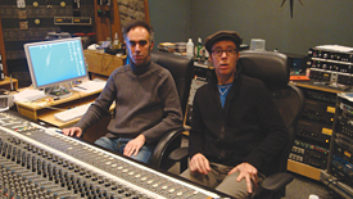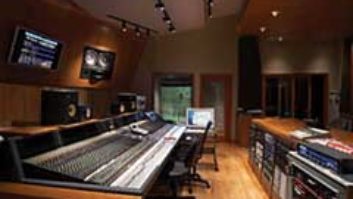The whole look, feel, vibe and sound of the Universal Audio 2108 Dual Mic/Instrument Preamplifier say “rock” to me. Maybe it’s the black-anodized front, no-nonsense operation like its sibling, the UA 1176LN Peak Limiter. The 2108’s design was inspired by the original 1108 line amp developed by Bill Putnam Sr. in the early ’60s to use in his recording consoles and subsequently in the 1176. The 2108 uses a newly designed J-FET mic-input stage that allows precise control over saturation characteristics, followed by an 1176 line amp and output transformer. In the spirit and heritage of UA CEO/president Bill Putnam Jr., this is his father’s preamp; enhanced, modernized and reincarnated into a versatile and worthwhile unit reminiscent of the 1108 amplifier and a bygone era.
INSIDE AND OUT
Right out of the double shipping boxes, I saw that the 2108’s finish, white silk-screened labeling, knobs and E-Switch push buttons all matched the 1176. To obtain an extremely low-noise spec, the 2108 is powered by an external power supply; one power supply is included and required for each 2108 in your rack. The 2108 is ruggedly constructed and housed in an all-steel cabinet. Service techs will like the neat and spacious circuit board layout and the way all of the components and beefy transformers are securely mounted. Metal polypropylene-coupling capacitors and metal film resistors are used throughout. It’s hand-built like a tank; I would have no qualms about taking this unit on the road or renting it out. With the 1176’s output-stage circuit and specially made UA-5002 output transformer, the 2108 shares the same sonic world: one that is inhabited by many top mixers who, just for the sound, strap a pair of 1176s across the stereo bus without compressing.
Each of the two identical preamp channels on the 2108 uses two control knobs to set recording levels. The Gain control uses a sealed ElectroSwitch rotary switch and sets gain in 5dB steps from a minimum of 25 dB to a maximum of 65 dB. The Level control is a smooth-feeling pot that sets final output levels from zero (off) to 10 (i.e., the full value of the Gain knob setting). I found the 2108 was best used in a deliberately overdriven mode like a guitar amp with a master volume control: Wind up the input Gain knob and turn down the output Level control. This produces harmonic-enriched soft saturation and, being a solid-state, all-discrete, Class-A preamp, sets the 2108 apart from most other transistor mic pre’s. Overdriving transistor gear is nothing new, but producing many usable and repeatable results is.
After the Gain and Level controls, each channel has a +48-volt phantom-on/off, phase reverse and input/output meter switch. For metering, the 2108 uses a tri-colored LED mounted in a nice-looking, glass jewel housing. With the Meter button pushed in, any signal present on the input causes the jewel to glow green, changing to amber with more level and then red when circuit saturation begins. The manual states that red does not indicate clip, but I wish there were output clip LEDs, anyway. With the button out, you’ll see output levels with red that indicate a +12dB output at the rear panel XLR output connector. While recording, you’ll see it changing colors all of the time, a quick check clearly seen from across the control room. Precise metering is best accomplished at your tape deck, MDM or DAW.
There are two ways to get audio into the 2108: the standard XLRs on the back panel or the gold-plated, high-impedance, ¼-inch jacks on the front. The rear XLR jack is active only when the Gain control is in any position between 30 dB and 65 dB. The hi-Z jack automatically takes over when the Gain control is set to the 25, 30 or 35dB positions. Therefore, it is impossible to have, say, 25 dB of gain for the XLR or 30 db of gain for the hi-Z. Because there are no -10 or -20dB mic-attenuator positions onboard, you may have to use more gain than usual and reduce the output level control to achieve proper recording levels. Conversely, if you run out of gain, then you’ll have to make it up somewhere else in the recording chain. I found out that none of these initial concerns mattered much when I used the 2108 for my recordings. High on my wish list would be separate XLR line-level input jacks to process whole mixes through the output section of the 2108; get that 1176 sound without tying up two 1176s!
Last, but certainly not least, is impedance switching. Two different input windings on a custom-made mic input transformer are available. This is the same transformer used in the UA 2-610 tube mic preamp, and I’m happy to see this method used because it is the only correct way to incorporate this fine feature on a mic pre with transformer input. The Z-In Select switch changes the XLR input between the 1k-ohm and 4k-ohms windings. Z-In also toggles the hi-Z input jack between 58k-ohm (switch in) and 2Megohms (switch out) impedance. The manual suggests that the 58k position for -10dBv signals from synths or active instrument pickups and 2Megs for passive pickups where any loading (of the preamp) might change the instrument’s sound.
IN THE STUDIO
My first job for the 2108 was recording a Martin D-16 acoustic guitar. I found that the 2108 worked fine for acoustic: clean, quiet and smooth, but not boring. I did run out of gain when recording a fingerpicking part a foot away with my low-output Royer 121 ribbon. I could, of course, move the mic closer or make up gain somewhere else. No biggie, because this preamp is so quiet that there aren’t any worries about noise buildup when using a big compressor after it. I also tried the hi-Z input to record the Fishman pickup system installed on the guitar. The 58k impedance position worked well for no additional noise or coloration. Rotating through the different Gain knob settings is clean, and I was able to overload easily for a very retro-direct sound.
While recording electric guitars, I was amazed: The 2108 might be the ideal preamp. You can record guitar sounds transparently at full recording levels by using the minimum necessary Gain knob setting and keeping the Level control fully up. You’ll get mostly green and amber flashing LEDs with a few reds. The fun begins when you push more Gain and turn down the Level control to maintain proper recording levels. The 2108’s true personality surfaces, producing a much more present and “in your face” sound. This is not like using an equalizer, closer mic placement or a compressor. Guitar sounds broadened and projected farther out of my monitor speakers. I tried the Royer ribbon, SM-57 and AKG C-414ULS mics on a Fender Champ amp. The impedance switch definitely made a big difference with ribbon mics. The Royer has a rated output impedance of 300 ohms, so the 1k-ohm position was louder and more present to me. You can notice a slight difference when changing impedance on the SM-57 dynamic moving-coil mic. I found myself checking the sound differences by changing impedance with every new mic setup and recording job.
Next, I went over to Jimmy Hunter’s Cazador Recording in Hollywood for vocals, snare drum overdubs and direct Fender bass. We were recording into a Pro Tools HD system with a 192 interface. I close-miked the top and bottom of a vintage 1967 6½-inch Ludwig chrome snare with a pair of Audix ADX-90 electret condensers. Plenty of gain here; again, winding up the Gain knob to 50 dB and cranking back the Level knob produces a thick and dense sound that is great for double-tracking.
On vocals, I used an AKG 414ULS without pad or roll-off. My singer was about a foot away from the mic and pop filter. I liked the fact that while using the 50dB gain setting, I had plenty of Level knob adjustment to “ride” vocal levels up and down, while keeping softer sections loud enough and the loud sections from over-compressing. Overloading the preamp was fun, although the results were unpredictable with live vocal overdubs. I found that if the transistor AKG mic and the 2108 overloaded on the same vocal peak, it was not pretty. For grungy vocal sounds, I’d use a cheap dynamic and overload the 2108.
Lastly, the pre-CBS Fender P-Bass sounded very clear and present using the hi-Z input. For the passive pickups, I kept the Z-In Select switch in the 2-meg position for the loudest and clearest sound. Using the lowest Gain setting at 25 dB and the Level knob fully up, I got a perfect level into a following compressor. Overdriving results (for me) depend on your player’s touch and technique: Every fret noise, string squeak or buzz is greatly amplified. The DI sound is like any well-designed FET-based direct box.
The Universal Audio 2108 Dual Mic and Instrument Preamplifier stands out from other units, with a long list of sonic options when recording any mic or direct source. I found its operation straight-ahead and simple, its sound unique for a solid-state pre and its build quality excellent. Having the overdrive/saturation feature and musical sound of an 1176 alone make it a tool worth having in any studio. The unit sells for $1,695 MSRP.
Universal Audio, Box 3818, Santa Cruz, CA 95063; 831/454-0630; www.uaudio.com.
Thanks go to engineer Aaron Kaplan at Icon Recording Group (Hollywood), producer Jimmy Hunter, and Tim Prince and John Hinson at U.A. Barry Rudolph is an L.A.-based recording engineer. Visit his Website atwww.barryrudolph.com.
UA 2108 SPECS
Microphone-input impedance: selectable, 1 k-ohm or 4 k-ohms
Hi-Z input impedance: selectable, 2 Meg or 58 k-ohms
Maximum microphone-input level: +8 dBu
Maximum output level: +26 dBu
Recommended minimum load: 600 ohms
Frequency response: 20 to 20k Hz, ±1 dB
Maximum gain: 65 dB
Noise: -165dB EIN @ 65dB Gain
Dynamic range: >100 dB
CMRR: 50 dB @ 1 kHz
Power requirements: 115 volts/230 volts
Weight: ~11.5 pounds (5.2 kg)
Dimensions: 1U rack, 11.5 inches (29.2 cm) deep





